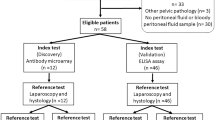Abstract
Objective
To investigate the innate characters of 3 endometriosis (EMT) syndromes, blood stasis (BS), qi stagnation and blood stasis (QSBS) as well as Shen (Kidney) deficiency and blood stasis (KDBS) in terms of proteomics, lay a molecular biological basis for the differentiation of various blood stasis syndromes of EMT, establish a EMT microscopic syndrome differentiation and diagnosis system in terms of proteomics, discover the evolution principles and therapeutic targets of these EMT syndromes, and search their signifificant molecular markers and genetic intervention targets.
Methods
Six specimens from the ectopic and entopic endometrium tissues of patients with EMT in each syndrome, BS, QSBS as well as KDBS, in the early proliferative phase of the menstrual cycle, and 6 specimens from normal endometrium tissues in the early proliferative phase of the menstrual cycle were obtained. Three groups were formed in each syndrome by mixing two random specimens in equal amount, and then their respective two-dimensional electrophoresis graphs were obtained after total protein extraction. Finally, the detected differences in protein expression were identifified through matrix-assisted laser desorption Ionization-time of flflight mass spectrometry (MALDI-TOF/MS) and protein database.
Results
The results of differential proteins expressed in each syndrome were shown as follows: BS syndrome had 2 differential proteins in entopic endometrium and 1 differential protein in ectopic endometrium; KDBS syndrome had 3 in entopic endometrium and 3 in ectopic endometrium; and QSBS syndrome had 3 in entopic endometrium and 4 in ectopic endometrium. It was found out that annexin was highly expressed in both entopic and ectopic endometrium of KDBS syndrome; and myosin light chain 3 was highly expressed in both entopic and ectopic endometrium of QSBS syndrome.
Conclusion
There are differential protein expressions among the 3 EMT syndromes, which might be the inner origin of syndrome characters, and these differential proteins might be the candidate biomarkers for the pathogenesis of various EMT syndromes.
Similar content being viewed by others
References
Li XB. Thinking about the research of proteomics and traditional Chinese medicine syndrome type. Liaoning J Tradit Chin Med (Chin) 2008;35:203–205.
Huang JY, Wei SB, Wen Y. The proteomic research of EMT syndrome type. Lishizhen Med Mater Med Res (Chin) 2012;23(1):204–206.
Kennedy S, Bergqvist A, Chapron C. ESHRE guideline for the diagnosis and treatment of endometriosis. Human Reproduction 2005;20:2698–2704.
State Administration of Traditional Chinese Medicine of China. Clinical disease diagnosis standard of traditional Chinese medicine. Nanjing: Nanjing University Press; 1995:91-92.
National Technical Supervision Bureau. Clinic terminology of traditional Chinese medical diagnosis and treatmentsyndromes. Beijing: China Standard Press; 1997:113-114.
Zheng XY, ed. Guiding principle of clinical research on new drugs of traditional Chinese medicine. Beijing: China Medical Science Press; 2002:178–180.
Bradford MM. A rapid and sensitive method for the quantitation of microgram of protein utilizing the principle of protein dye binding. Analyt Biochem 1976;72:248–254.
Candiano G, Bruschi M, Musante L, Ghiggeri GM, Carnemollar B, Oreddhia P, et al. Blue silver: a very sensitive colloidal Coomassie G-250 staining for proteome analysis. Electrophoresis 2004;25:1327–1333.
Huang YQ, Huang Z, Sun L. The relationship of abdominal cavity fluid matrix metalloproteinases-1, -2, -3, -9 and EMT. Guangdong Med J (Chin) 2010;31:433–435.
Kong LJ, Li GH, Li LY. The relationship of blood stagnation syndrome type of old men and cell adhesion molecule. J Shandong Tradit Chin Med Univ (Chin) 2003;27:274–276.
Zhang HS, Jia YH, Hua HY. The research of urine metabolomics of phlegm syndrome and blood stagnation syndrome of angina pectoris. Chin J Basic Med Tradit Chin Med (Chin) 2010;16:126–128.
Zhao HH, Wang W, Guo SZ. Proteomic of blood stagnation of unstable angina pectoris of coronary heart disease. Chin J Arterioscl (Chin) 2008;16:545–548.
Ma XJ, Yin HJ, Chen KJ. The relationship research progress of blood stagnation and inflammation. Chin J Integr Tradit West Med (Chin) 2007;27:669–672.
Liu Y, Li SH, Li XH. The research of inflammation immune related gene differential gene of qi deficiency blood stagnation of big mouse. Chin J Inform Tradit Chin Med (Chin) 2008;15(5):33–36.
Harada T, Kaponis A, Iwabe T, Taniguchi F, Makrydimas G, Sofikitis N, et al. Apoptosis in human endometrium and endometriosis. Hum Reprod Update 2004;10:29–38.
Chae SJ, Kim H, Jee BC, Suh CS, Kim SH, Kim JG. Tumor necrosis factor (TNF)-receptor gene polymorphisms and their serum levels in Korean women with endometriosis. Am J Reprod Immuno 2008;60:432.
Wang JH, Qiu RQ. The relationship research of kidney deficiency blood stagnation syndrome type and endometrium pathology as well as cell apoptosis controlling gene bcl-2, bax. J Fujian Tradit Chin Med Univ (Chin) 2007;17(1):3–6.
Author information
Authors and Affiliations
Corresponding author
Additional information
Supported by National Natural Science Foundation of China (No. 30973770)
Rights and permissions
About this article
Cite this article
Wen, Y., Wang, Y., Feng, Tt. et al. Differential Proteomics Analysis of Endometriosis in Blood Stasis Syndrome. Chin. J. Integr. Med. 24, 925–929 (2018). https://doi.org/10.1007/s11655-017-2401-4
Accepted:
Published:
Issue Date:
DOI: https://doi.org/10.1007/s11655-017-2401-4




